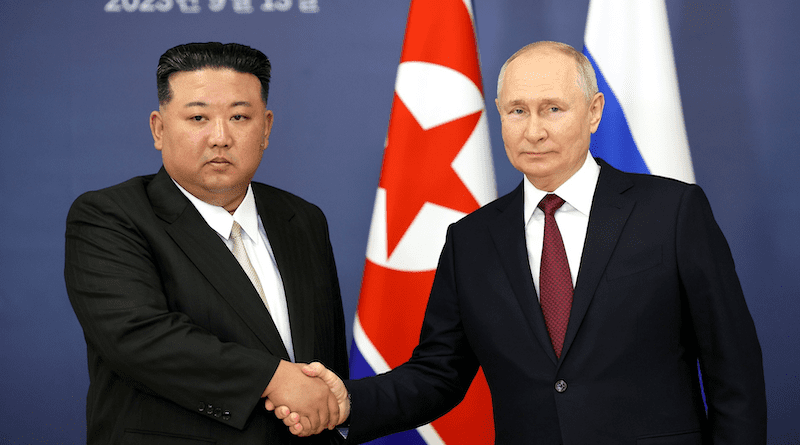The Resilience Of Scientific Diplomacy In North Korea – Analysis
By Niki Alsford and James Hammond
On 13 September 2023, a significant event occurred at the Vostochny Cosmodrome in the Russian Far East. North Korean Supreme Leader Kim Jong-un and Russian President Vladimir Putin convened for a meeting that sparked intrigue and international concern.
Speculation was rife about the agenda of this meeting. Rumours circled that it revolved around a potential exchange of North Korean ammunition stockpiles for Russian assistance in developing space technology and resource aid. If substantiated, this would undoubtedly contravene numerous United Nations Security Council resolutions. While China and Russia, with their veto power at the Security Council, would likely shield North Korea from any punitive measures, it could still face sanctions from a number of countries or from the European Union.
These sanctions could have wider impacts on humanitarian or scientific projects, underscoring a vital and sensitive aspect of international diplomacy.
Scientific exchanges, particularly in environmental science, play an essential role in bridging gaps between nations, fostering cooperation and enhancing global understanding. One such ongoing scientific exchange is the monitoring of volcanic activity on Mount Paektu. It has emerged as a symbol of diplomacy’s unique potential to unite nations, even amid complex geopolitical dynamics.
With a towering height of 2744 metres, Mount Paektu straddles the border of China and North Korea. It is a site of immense historical, cultural and geological significance. According to Korean folklore, Paektu is the birthplace of Dangun, the founder of the first kingdom on the Korean peninsula. For the Manchu people, it holds mythical importance as the birthplace of Bukuri Yongson, an ancestor of the Qing Dynasty founders. As far back as the Khitan people of the Liao Dynasty, China has referred to it as Changbaishan or ‘long white mountain’.
Mount Paektu’s volcanic eruptions over the last few thousand years have propelled it to fame among volcanologists. Mount Paektu’s ‘Millennium Eruption’, recently dated to 946 AD, stands out as one of the largest eruptions in human history, surpassing even the infamous Krakatoa in magnitude. This geological marvel has attracted scientists from around the world, eager to unravel its mysteries and understand its implications.
Collaborative efforts centred around Mount Paektu have yielded remarkable milestones over the years. They facilitated the deployment of North Korea’s first broadband seismometers, a tool used to understand the current state of the volcano. They also enabled the first cross-border geophysical study, bridging the gap between North Korea and its neighbours. This collaboration accurately dated the Millennium Eruption, dispelling the uncertainty that had shrouded this historical event.
Despite the intricate geopolitics at play, this scientific collaboration has stood resilient for 12 years, defying political pressures and constraints. The endurance of this cooperation amid evolving circumstances speaks to the power of science as a common ground for nations to come together and transcend diplomatic hurdles.
For the United Kingdom, whose official policy toward North Korea is one of critical engagement, the collaboration around Mount Paektu is emblematic of its favoured approach. The United Kingdom is unequivocal in its opposition to North Korea’s nuclear weapons programme, proliferation activities and human rights record. Still, it recognises the value of engaging North Korea through credible dialogue, believing that continuous and sustained engagement is the path to progress.
In this context, Mount Paektu serves as an ideal platform for engagement. It offers a common ground with clear mutual benefits for cultural, environmental and developmental cooperation. It is a tangible example of how science can bridge divides and foster understanding, even in the most challenging diplomatic contexts.
Yet challenges persist. Sixteen export licenses have been submitted to the UK and US governments as well as the UN Security Council to support the ongoing work around Mount Paektu. Some of this equipment has been deemed ‘dual-use’, raising concerns about its potential military applications and curtailing its use in North Korea. Flexibility and cooperation from all parties is necessary to achieve scientific objectives without compromising security.
Looking to the future, the importance of the United Kingdom’s policy of critical engagement with North Korea becomes increasingly evident. The global community cannot afford to isolate North Korea completely, especially when there are clear opportunities in environmental science, including at Mount Paektu, which are resilient to changing sanctions and offer opportunities for collaboration and dialogue.
Ongoing scientific collaboration on Mount Paektu showcases the potential of diplomacy through science, offering a unique opportunity for nations to work together, even amid complex geopolitical challenges. The United Kingdom’s policy of critical engagement, which recognises the value of dialogue and cooperation, aligns well with the principles that underpin this collaboration.
Amid the uncertainty of international relations, Mount Paektu serves as a beacon of hope — a reminder that science can transcend borders and bring nations together for the common pursuit of knowledge and understanding. In an increasingly interconnected world facing truly global challenges such as climate change and the increasing use of sanctions, these collaborations are more crucial than ever.
About the authors:
- Niki Alsford is Professor in Asia Pacific Studies and Head of Asia Pacific Institutes at the University of Central Lancashire.
- James Hammond is Professor in Geophysics and Director of the Mount Paektu Research Centre at Birkbeck, University of London.
Source: This article was published by East Asia Forum

